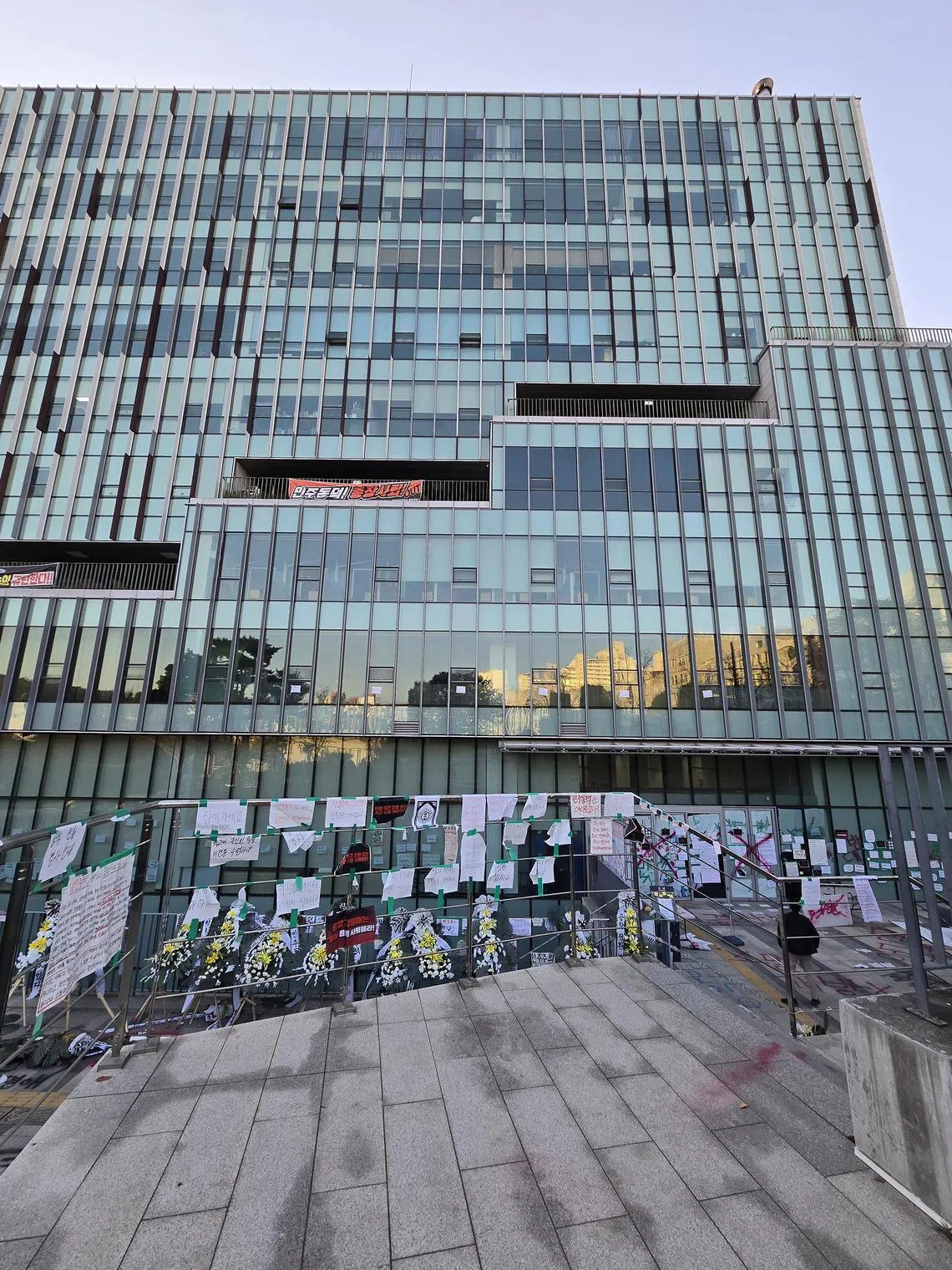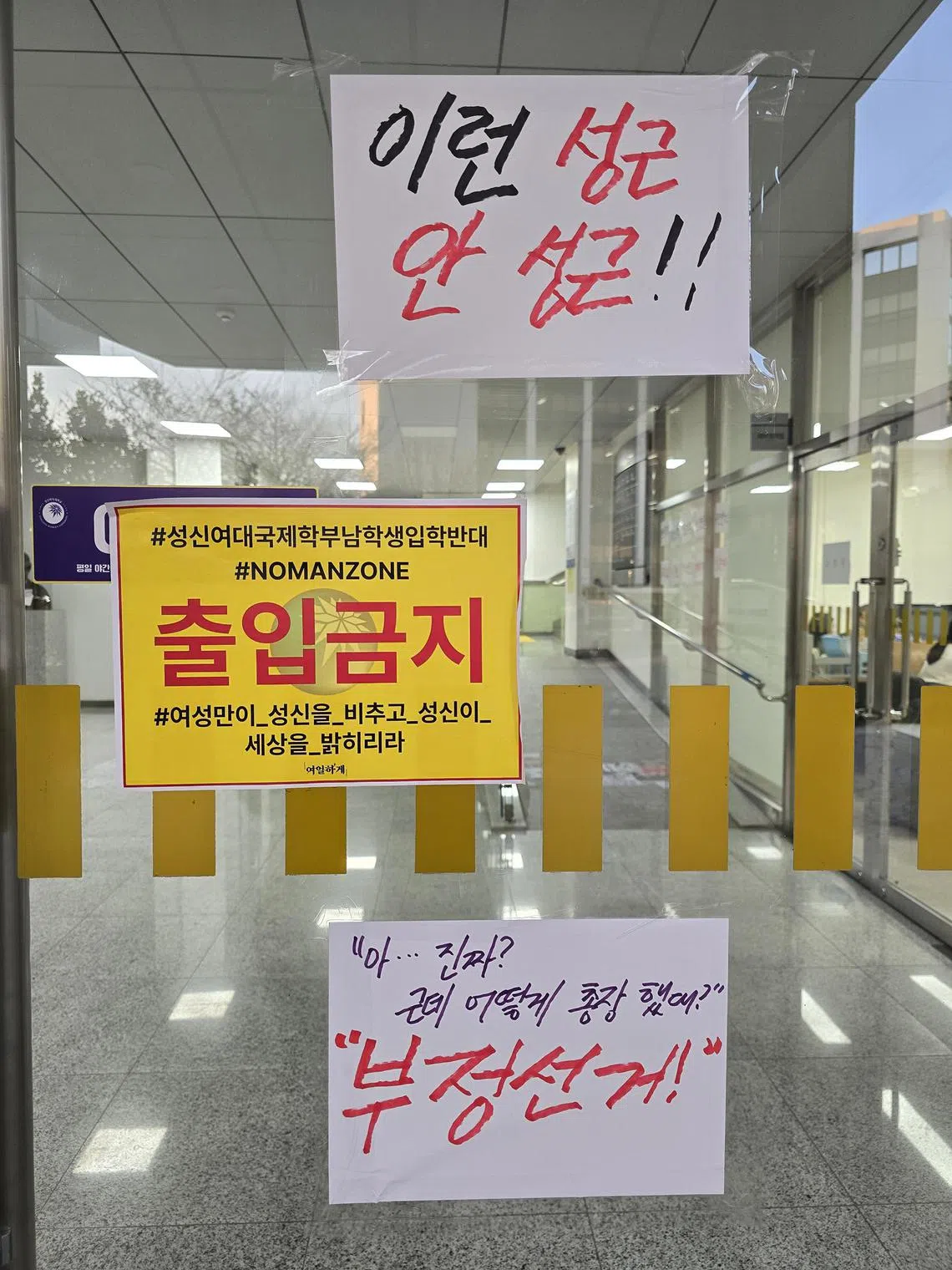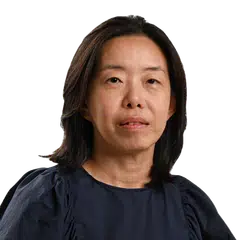No men allowed: Co-ed plans spark protests in women’s universities across S. Korea
Sign up now: Get ST's newsletters delivered to your inbox

Students at Dongduk Women's University in Seoul holding a rally on campus to protest against plans to transform the institution into a co-educational university.
PHOTO: EPA-EFE
Follow topic:
SEOUL - It is just two weeks before the final exams. But things have come to a standstill at Seoul’s Dongduk Women’s University, where students have stopped attending classes since Nov 11.
At the school’s annexe outside the main gate, a row of funeral wreaths has been placed in a symbolic gesture. There are protest slogans spray-painted on the ground and protest notes pasted on the building’s facade, calling for the university to exercise more democracy and revoke the plans for co-education.
The school gate – pasted with handwritten protest letters and notes – remains tightly shut, while a security guard checks student cards before allowing the women entry into the campus.
News broke on Nov 7 that the school was considering a transition to co-education, and on Nov 11, Dongduk students started occupying the school’s buildings in protest. They argue that such a move would go against the school’s founding principles, which is to ensure women’s equal rights to education.
The protest has since spread to other women’s universities like Sungshin Women’s University, also in Seoul, and Gwangju Women’s University in the south-western part of the country.
South Korea’s birthrate woes

Students pasted protest notes and laid funeral wreaths at the Dongduk Women’s University annexe.
ST PHOTO: WENDY TEO
But resistance has been strong. In 2015 and 2018, two women’s universities were forced to withdraw their co-educational plans following fierce student opposition.
South Korea has a history of gender-separated education institutions. Women-specific colleges were established mostly from the late Joseon dynasty (late 1800s to early 1900s), by either Christian missionaries or women’s activists.
Today, South Korea has 14 women-only colleges – all privately run – with most located in Seoul. There are about 200 universities across the country.
Many of the other women-only universities’ student councils have since issued statements of solidarity supporting Dongduk, Sungshin and Gwangju universities.
When The Straits Times visited the Dongduk university campus on Nov 22, student council president Choi Hyun-ah and other council members were busy clearing some of the protest debris from outside the university’s annexe.
“Our university was founded in 1950 as a women’s university, but now the school has announced its intention to transition into a co-educational institution.
“It did not inform the students in advance about the plans, despite it being such a major decision. This has caused significant anger among the students,” said the 22-year-old chemistry major.
At a general assembly of students held on Nov 20, some 2,000 students turned up and voted unanimously against the transition to co-education. The school has an enrolment of 6,500 students.
The school’s president has since issued a statement to explain that the co-education transition issue was a matter under discussion and not cast in stone, but the students do not buy into the argument.
Another council member Song Min-ju, 21, told ST she had always aspired to attend a women’s college, after hearing about sex crimes in other co-ed universities, such as hidden cameras in the women’s bathrooms.

At a general assembly of students held on Nov 20, some 2,000 students turned up and voted unanimously against the transition to co-education.
PHOTO: EPA-EFE
Yet, the journalism major insists the protest is not a feminist movement, but more an expression of their disappointment in the lack of respect from the school authorities over such a major decision.
She said: “It is true that the student population has been declining, so going co-ed could be an eventuality. But shouldn’t the school think this through with inputs from the students instead of pushing forward unilaterally?”
She was particularly incensed to have heard about the school’s plans to go co-ed from the teachers, rather than from the school administration itself.
“Some professors were telling their students that they would soon have male classmates starting from 2025, and we started freaking out because this is the first time we’ve heard about it,” said Ms Song.
Over at Sungshin Women’s University just a 15 minutes’ drive away from Dongduk, the university’s administration building was similarly defaced with graffiti and posters and strewn with debris. A bright yellow poster read “No Entry” along with “#NoManZone”.
On Nov 15, more than 1,200 of its students held a vigil protest following the university’s announcement to open admissions to male students from 2025, for its new International School of Korean Culture and Technology department which is specifically targeted at foreigners.
Students from both Sungshin and Dongduk denied that the protests were coordinated.

A sign at Sungshin Women’s University reads “No Entry”.
ST PHOTO: WENDY TEO
A Sungshin final-year student who wanted to be known only as Ms Park, told ST that classes are still ongoing and that the protests are far milder than what is going on at Dongduk.
Following the Dongduk protests, students at the Gwangju Women’s University held a similar protest on Nov 18 evening, lining wreaths around the campus and laying school jackets on the steps of the school buildings. The students were worried the school’s acceptance of male students to its adult learning courses from 2025 could be a prelude to co-education conversion.
The university has since released a statement insisting that there are no such plans, and that it is working to clear up any misunderstandings with the students.
Over at Dongduk, the situation remains tense as the school announced its intention on Nov 26 to file an injunction against the student protesters, and to seek compensation from the students for the damage estimated to cost 5.4 billion won (S$5.2 million).
The dispute has spilled over to the political arena, with both the ruling party and opposition bickering over different positions.
Ruling People Power Party chief Han Dong-hoon had posted on social media on Nov 23 that violence should not be tolerated and called for the instigators to be held responsible for the property damage.
This sparked a sharp rebuke from the opposing Democratic Party, whose floor leader Jin Sung-joon criticised Mr Han of blaming only the students while not addressing the undemocratic actions of the university administrations.
The chairman of public agency Human Resources Development Service of Korea, Mr Lee Woo-young, posted on social media on Nov 16 that he would not want to hire candidates who graduated from Dongduk.
This triggered an immediate backlash, with the Korean Ministry of Labour and Employment stepping in to warn against discriminatory hiring practices. Mr Lee’s post has since been removed.
While some have suggested that the protests are a manifestation of South Korea’s chronic gender inequality struggle – a World Economic Forum’s gender gap ranking report released in June 2024 placed South Korea 94 out of 146 countries – sociology professor Shin Kwang-yeong does not see it that way.
Prof Shin, who teaches at Seoul’s Chung Ang University, told ST: “Students see themselves as a key stakeholder in the university. So the school’s top-down decision-making is what is provoking the students’ anger and discontent, since such a decision would completely change the identity of the university.”


